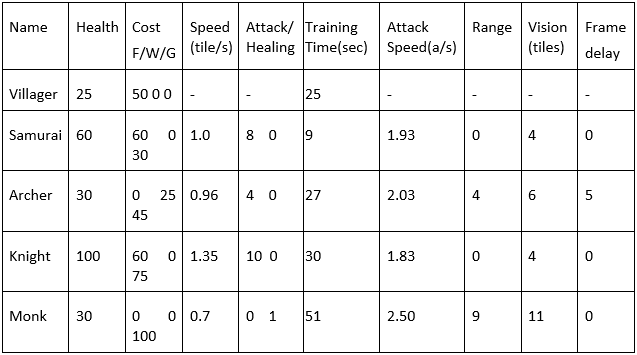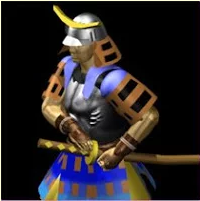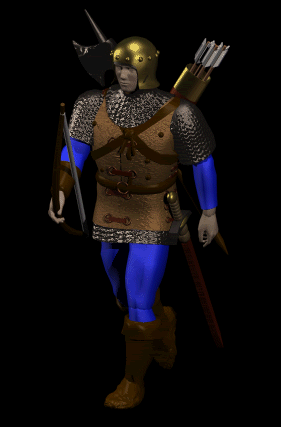Game Design Document - GangBug/AgeofEmpiresII GitHub Wiki
Introduction
Overview
Age of Empires 2: Jigoku Do it’s a real-time strategy game designed for PC. The player will be in control of friendly troops and buildings with the objective of overcome all challenges he faces. Jigoku Do will have three consecutive missions played in the same scenario, each one with a particular objective.
Every quest is designed to push the boundaries of the player to the limit forcing him to create new and unique strategies for each mission. The player should use his wisdom and ingenuity to take advantage of the landscape in order success in every challenge he faces.
Our Vision
Jigoku Do will offer to the player these following experiences:
- Challenging: Each quest will be a challenge to the player forcing him to make new strategies.
- Exploration: Ingame Map will count with different zones and hidden resources.
- Unique experiences: Each match will differ to the previous one.
Game Pillars
These following concepts will be the base of Jigoku Do:
- Unique Bosses: Powerful enemy creatures with unique mechanics.
- Strong Setting: Samurais vs Demons
- Hardcore: Strong learning curve. Previous experience in RTS games highly recommended.
- Replayable: Each game differs from the previous one. Multiple winning strategies.
References
 Age Of Empires 2: Jigoku Do is a tribute to the same original game mixing innovative elements that have contributed other games to the industry.
The first referenced game is Diablo 2 since it incorporates part of its theme in enemy troops being these the same demons of the game. As a second reference we have chosen Warcraft 3. In this game we begin to distinguish extraodinary troops and superior to the rest with special abilities that we have based on the incorporation of a final boss to our campaign.
Age Of Empires 2: Jigoku Do is a tribute to the same original game mixing innovative elements that have contributed other games to the industry.
The first referenced game is Diablo 2 since it incorporates part of its theme in enemy troops being these the same demons of the game. As a second reference we have chosen Warcraft 3. In this game we begin to distinguish extraodinary troops and superior to the rest with special abilities that we have based on the incorporation of a final boss to our campaign.
Gameplay
Core Gameplay
Objectives: The main objective of AoE 2: Jigoku Do is to complete each quest successfully. In order to do that the player will need to use his wisdom and ingenuity to build new strategies that fit the enviroment and the enemy, using his troops and natural resources around him.
- Small: Defeat hostile Units.
- Tangible Reward: Remove enemy unit.
- Intangible Rewardble: Death sound.
- Medium: Complete quest.
- Tangible Reward: Change of music.
- Intangible Reward: Music swap.
- Big: Complete the campaign.
- Tangible Reward: Defeat the enemy final Boss.
- Intangible Reward: Death sound and victory music.
Gameplay Subsystems
All the gameplay of Jigoku Do is based on two systems:
- Creation and control of units.
- Collection of resources.
Unit creation and management
The player will have the ability to control his troops. To exert such control, he will first select and then command movement or attack.
- Move: all troops will have the ability to move on a 2d plane which will contain all elements of the game.
- Attack: The troops will have the ability to attack any enemy unit within reach. The player will have the option to create more troops in the relevant buildings in exchange for the necessary resources.
The player learns the functioning of the game (rules, goals and rewards) by trial and error, and above all by previous experience if he has played the genre or is a former AoE player. There is no tutorial or guide except GitHub.
Resources gathering and management
The terrain offers the player a number of limited resources that he will manage to complete the missions in the best way. To collect resources, you must have a basic unit (peasant) and a resource collection center for each resource:
- Lumber Mill: Wood
- Mine: Gold
- Farm: Food
Mechanics
The player will interact with the entire game through two elements. Mouse and a Keyboard.
Cursor
Main player-game interaction element through which you can select units and buildings. The gameplay is based on the original RTS Age of Empires 2.
Select
In both X and Y axys the player can select by holding down the left button.
Order
With the right mouse click once a troop is selected, you can order different tasks: building, collecting, moving and attacking. With the left mouse click if it is a basic unit the one that has selected can order the construction / repair of buildings.
Aesthetics
Characters
Player1 and Player2 (AI)
Ally Units
Troops with a distinguished blue color.
Enemy Units
Demonic troops with a distinguished red color.
HUD
Current Mission
In the upper right corner of the screen we'll display the current goal that the player needs to achieve.
Timer
In the top of the screen, just in the middle, the time limit to complete the three missions will be displayed. ####Minimap The minimap will show a representation of the map on a lower scale, and it will be displayed in the lower right corner of the screen. ####Selected Unit Located in the bottom of the screen, it will let the player know which unit or units are selected, and their respective information (health, attack, range, name and civilization). Every unit currently selected will also have a green circle under it.
Options for the selected unit
In the lower left corner of the screen we'll show the player through different icons (with a description for each of them when you hover over with the cursor), all of the tasks and options for a unit currently selected.
Environment
Jigoku Do has an extensive map to explore populated with all kind of elements.
- Trees: Different kinds of trees which will provide the player with wood, a resource that they'll use later.
- Mountains: a chain of mounds which will difficult the path for allied and enemy troops alike.
- River: the map of Jigoku Do will be divided in two halves by a large river which will go from north to south in a vertical position.
- Bushes: some minor flora that will allow the player to harvest food out of it.
##Dynamics Jigoku Do causes different behaviors in the player. In the following table we see these dynamics classified by the elements that provoke them:

Units
Friendly Units

Villager

Basic unit responsible for collecting resources, building and repairing buildings.
Samurai

Main unit of the Japanese army. Attacks melee and resists considerable damage.
Archer

Remote unit with fast but weak shooting rate against enemy attacks due to poor health.
Knight

Strongest and expensive troop of the Japanese army. Fast and effective against both melee and ranged enemies.
Hostile Units

Final Boss

Our final boss will consist of three different mechanics:
- He will spin around himself dealing 50 HP damage to everything around 3 tiles around him every 16 seconds.
- Every time he looses 8% of his HP he will spit fire in a front line (2x10 tiles).
- Every 12 seconds he will spawn between 8 to 12 Zerglings. This Final Boss will have a total of 2000 HP and the length of the fight will vary depending of the player's size army. And won't follow the player outside his chamber, if the player goes outside the boss will go back to his initial position and restore full health.
Buildings
Town Center

Will be used to create new Villagers.
Barracks

Will be used to create new Samurais.
Archery Range

Will be used to create new Archers.
Stable

Will be used to create new Knights.
Mining Camp

Lumber Camp

Map and Campaign
Player Inicial Spawn Point
 In this ubication the player will start the campaign of the game. It's first objective will be to recover the Village which will be currently under siege of enemy demons. It will begin a countdown of 40 minutes, which in case it arrives to an end the final boss will teleport to the player village and attack him.
In this ubication the player will start the campaign of the game. It's first objective will be to recover the Village which will be currently under siege of enemy demons. It will begin a countdown of 40 minutes, which in case it arrives to an end the final boss will teleport to the player village and attack him.
Player Village

 At this point player will be going through the second quest which will consist of resisting waves of enemy troops (which will spawn every 45s to 1min with a total of 8 to 15 units per wave randomly selected) for 15 minutes.
At this point player will be going through the second quest which will consist of resisting waves of enemy troops (which will spawn every 45s to 1min with a total of 8 to 15 units per wave randomly selected) for 15 minutes.
Enemy Fortress
 The final state of the game will consist of assaulting the enemy fortress, hub of the final boss. The player will need to go deep into enemy territory and overcome every enemy he faces.
The final state of the game will consist of assaulting the enemy fortress, hub of the final boss. The player will need to go deep into enemy territory and overcome every enemy he faces.
##Core Loop In Jigoku Do the main loop will last between 10 and 20 minutes. It consists of an entire round of events that, in the case of being satisfactorily surpassed, will grant the player the relevant objective and allow him to move on to the next, having a total of three goals. The time between mission and mission is null.
Controls
Jigoku Do requires a keyboard and mouse to play.
Mouse
With the mouse the player will be able to select and command units in the same way as the friendly buildings.
Keyboard
The keyboard will have shortcuts predefined for the commands:
- ESC: Pause and Game Menu.
Buildings and Shortcuts

And of the following units:
- Villager -> Town Center.
- Warrior -> Samurais.
- Archer -> Archery.
- Knight -> Stable.
- Monk -> Monastery.
Contingency plans
Jikogu Do counts with a followed of Contingency Plans; In order of priority:
- Remove the ranged demon.
- Eliminate the first mission.
- Remove the upper demon.
- Eliminate the Knight and the Stable.
- Remove the Archer and the Archery Range.